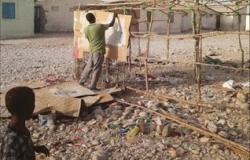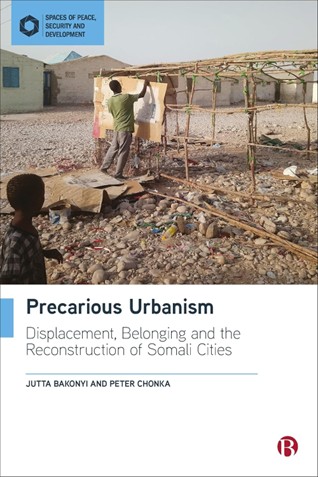Book Review - Precarious Urbanism: Displacement, Belonging and the Reconstruction of Somali Cities

Precarious Urbanism: Displacement, Belonging and the Reconstruction of Somali Cities by Jutta Bakonyi and Peter Chonka. Bristol: Bristol University Press, 2024. 234 pp., £80 hardcover 978-1529215229, £26.99 paperback 978-1529215236, £26.99 e-book 9781529215243
Interest in the plight of Internally Displaced Persons (IDPs) has ramped up in recent years, particularly given growing awareness that for the past two decades they have outnumbered refugees globally. There are few contexts where the situation of internal displacement has been so chronic as Somalia, where in the 1990s this was one of the factors motivating the United Nations to develop its Guiding Principles on Internal Displacement, published in 1998.
At the same time, recognition has grown that this is primarily an urban problem, with as many as 80% of IDPs believed to reside in urban areas. This book is the first dedicated study of what this mass displacement within urban areas actually looks like on the ground in Somalia and Somaliland, exploring the ways in which urban IDPs experience and contribute to remaking the city in four Somali cities: Mogadishu, Bosaso, Baidoa and Hargeisa. Across these cities, which have distinct histories of displacement and different socio-political characteristics, the study explores dynamics of place-making, infrastructure, livelihoods, service provision and belonging in the three types of spaces: informal settlements within cities, camps on the outskirts, and resettlement areas to which populations have been moved en masse. The book is rooted in a specific research project, and the introduction offers an admirable amount of methodological detail and reflection on the practical and ethical challenges of working in this context.
 Given the recurrent crises and waves of displacement in Somalia, and the mounting conflicts that continue to generate mass displacement in many surrounding countries in the Horn of Africa, the book is extremely timely. Yet it also brings a range of debates from urban theory and urban critical infrastructure studies into a context in which they are rarely deployed and unusually relevant. Indeed, the burgeoning literature on the provisional, improvisational and makeshift practices within precarious and ‘informal’ urban space finds striking resonances in the context of urban Somalia – a society rooted in nomadic cultures and faced with all kinds of temporal uncertainty.
Given the recurrent crises and waves of displacement in Somalia, and the mounting conflicts that continue to generate mass displacement in many surrounding countries in the Horn of Africa, the book is extremely timely. Yet it also brings a range of debates from urban theory and urban critical infrastructure studies into a context in which they are rarely deployed and unusually relevant. Indeed, the burgeoning literature on the provisional, improvisational and makeshift practices within precarious and ‘informal’ urban space finds striking resonances in the context of urban Somalia – a society rooted in nomadic cultures and faced with all kinds of temporal uncertainty.
The book’s empirical insights unfold over four main chapters, following the introduction and a chapter setting out the historical and geographic context. Chapter 3 outlines the overarching political economy of humanitarian urbanism in the four cities, and the various categories of actors that seek to make (and benefit from) the city in the context of displacement and humanitarian aid. Chapter 4 examines improvised infrastructure and access to services in contexts where the latter are intensely commodified, and the practices of accessing them highly gendered. Chapter 5 turns to the question of livelihoods and their intersection with practices of digital connectivity, examining both the affordances of digital tools and the ways they can entrench existing inequalities. Chapter 6, the final empirical chapter, turns specifically to the resettlement areas developed around the fringes of Bosaso and Hargeisa, and considers contestations over identity and belonging in these new marginal spaces of ambiguous temporality.
Through these discussions, the book layers successive aspects of the IDP experience into the analysis, folding its insights into relevant academic debates as it moves along. One especially interesting aspect of the empirical analysis relates to the discussion of ‘humanitarian entrepreneurship’ in Chapter 4, which lays bare the ‘political economy of urban rent-seeking that is intertwined with international aid’ (p. 53). The authors illustrate how various actors and intermediaries positions themselves in relation to camps, mediating between landowners, camp-dwellers and international organisations in order to secure access to rents from humanitarian support. New property relations and forms of speculation emerge, as particular peri-urban areas are positioned for further IDP settlement and associated resources and infrastructure. As well as fuelling displacement and even forms of gentrification, this political economy can also lead to people claiming space and building structures in camps in which they do not actually live. Yet, as the authors show, this political economy of humanitarian rent-seeking is rarely frowned upon locally, and seen as part of the moral economy through which aid is claimed and redistributed.
Further interesting insights come in relation to the gendered aspects of infrastructure and services, which intersect with socio-cultural differences between communities with urban backgrounds and those displaced from rural areas. Thus, for example, we see that local (urban) women do not want to marry displaced boys and vice versa, for reasons that connect to approaches to basic services: ‘The displaced boy does not want a wife that will not carry water on her back for the family’ (p. 94). Meanwhile, the ways in which infrastructures are assembled involves regular and often stark trade-offs, with the consequences of such decisions having particularly marked effects on women’s labour and bodies.
When considering the ubiquitous role of digital infrastructures in relation to service access and the pursuit of an income, the book avoids the pitfalls of techno-optimism. While acknowledging the ways in which ICTs and mobile money have facilitated innovations in humanitarian support and economic opportunities, the telecommunications sector is not politically neutral and nor does the use of digital tools erase inequalities in access to resources. By dissolving spatial and temporal distance, mobile money can also create opportunities for abuse of the vulnerable, if they do not have immediate access to the knowledge and networks that safeguard against scams and the non-delivery of payments. Implicit here is that the trust-based networks on which Somali finance has long been predicated have both facilitated effective mobile money systems and fostered threats to the very same systems of trust, as these social relations become ‘datafied’.
A similarly measured approach is taken to the discussion of resettlement schemes. These are acknowledged to sometimes increase tenure security and service access, as well as allowing for relatives to reunite – yet also can increase economic precarity and socioeconomic disconnection from the city due to distance.
With regard to questions of identity and belonging, the book’s attention to forms of inter-group discrimination (which include but go beyond clan differences) that emerge in the context of displacement and resettlement do much to counter prevailing narratives about the homogeneity of Somalis and Somali culture. While the ‘homogeneity narrative’ has long been critiqued, the book’s findings about dynamics of belonging in an urban IDP context bring a new spatial lens to questions of fractured citizenship within the Somali territories. Moreover, from an urbanist perspective there are also intriguing findings about how these questions of belonging play out in relation to people’s attitudes to living in urban contexts. While the anonymity of city life is often cited in wider literature as a reason that people want to migrate to urban areas, some of the subjects of this study suggest that urban anonymity is a threat to them: ‘I cannot live in the town by myself since I will not be recognized by the majority of the people, and they may suspect me and think I am a spy and kill me.’ While experiences of the benefits and drawbacks of anonymity inevitably vary, this extreme example perhaps reflects the idiosyncratic nature of social relations and divisions in the Somali context.
In sum, Jutta Bakonyi and Peter Chonka have produced a very important contribution to debates on urbanization and urbanism in contexts of chronic displacement, offering fresh insights on city-making amid humanitarian crisis and entrepreneurship. Reading and reflecting on the book in 2025, following the announcements of massive cuts to international aid in the US and elsewhere, one cannot help but wonder how these dynamics of precarious urbanism – which have in different ways been both fuelled by and mitigated by humanitarian aid – might now change. This book forms an important starting point for anyone concerned not just with urban displacement but, perhaps, with a fast-emerging post-humanitarian urbanism.
Tom Goodfellow is Professor of Urban Studies and International Development in the School of Geography and Planning at the University of Sheffield.


